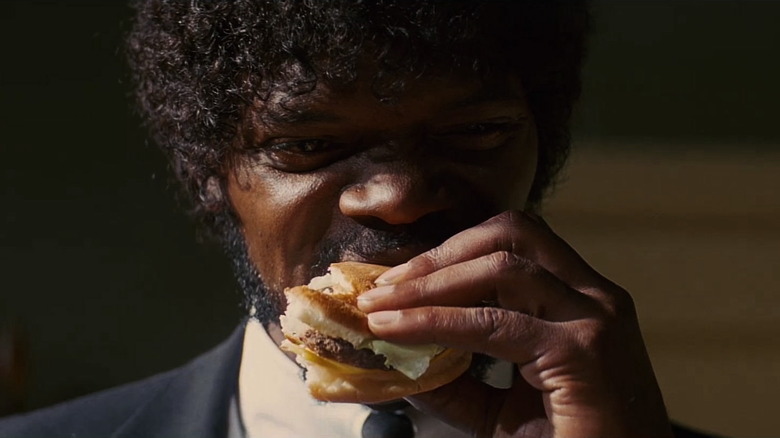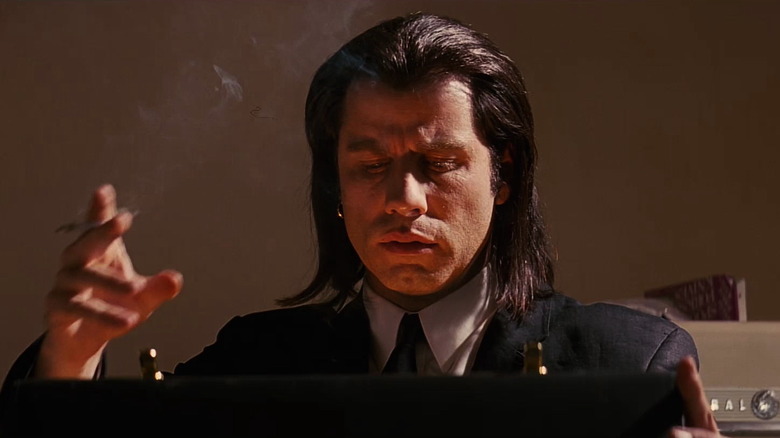Quentin Tarantino Shot Like Tony Scott For Pulp Fiction's Big Kahuna Burger Scene
For over a decade, we have lived in an age of haywire film editing. This is most evident in action films, where it seems like there is a cut to a different shot every half-second. It's dizzying, nauseating, and just downright confusing. Thanks to digital editing tools, the ability to make more and more cuts has become exponentially easier, and filmmakers everywhere are utilizing it, even if it is to the detriment of their own work. Most people associate this kind of editing with a filmmaker like Michael Bay, but it is far more pervasive than just him. It's everywhere.
I believe one filmmaker weaponized frenetic editing to his advantage, and that is the late, great Tony Scott. In nearly all of his films, Scott created symphonies of chaos, from the swirling aerial combat of "Top Gun" to the relentless charging ahead of the train in "Unstoppable." It's as if for every scene he sets up one million cameras to shoot the action from every possible angle, and in the editing room, he isn't looking for something to make spatial or logical sense. He is just looking to emotionally charge the audience through his cuts. This is true for action set pieces, but it's equally applicable to simple dialogue scenes between two characters in a room. By giving them the same cutting pattern, he is giving everything the same dynamic intensity.
Stylistically, Quentin Tarantino doesn't share much in common with Tony Scott, even though Scott did direct Tarantino's "True Romance." Tarantino is a far more deliberate and patient filmmaker than Scott, using a lack of cuts to build tension instead of pummeling you with them. However, Tarantino did look to Scott's technique for one specific scene in "Pulp Fiction" and crafted arguably the best scene in the film.
'We're popping all around'
Whenever there's a scene featuring many different characters, it's always a challenge to keep things in order; it's easy to lose track of who's in the room, where they are, and how they are reacting to what's happening in the scene. Most of the scenes in "Pulp Fiction" are fairly isolated, but the scene in which Samuel L. Jackson's Jules and John Travolta's Vincent retrieve the glowing briefcase is more complicated. There are five characters in that scene, and even though two of them don't say much, their presence is still crucial.
In shooting this scene, Quentin Tarantino felt the Tony Scott approach was best for capturing everyone in the scene as Jackson delivered his "Ezekiel 25:17" monologue, even though that's not his preferred way of shooting. He said to Film Comment back in 1994:
"Me, I like to hold for as long as I can before I have to cut, and then when I do cut, I want it to f****** mean something. At the same time, I love how Tony does it. The whole sequence in 'Pulp Fiction' where Sam Jackson and John Travolta come to the yuppies' apartment is covered in that style, because I'm dealing with Sam's big monologue and I've got all these guys all over the room. We're popping all around."
Though almost no one is moving, the chaos present in that scene is palpable, and I don't think you would have felt that without the rapid cuts. You wouldn't completely understand the terror. Because of this technique, it makes the instances where he does hold on something — like Jules drinking the Sprite — all the more powerful. Tony Scott would only get more frenetic in the 21st Century, and I'd be curious to see Tarantino try and ape that evolution.

